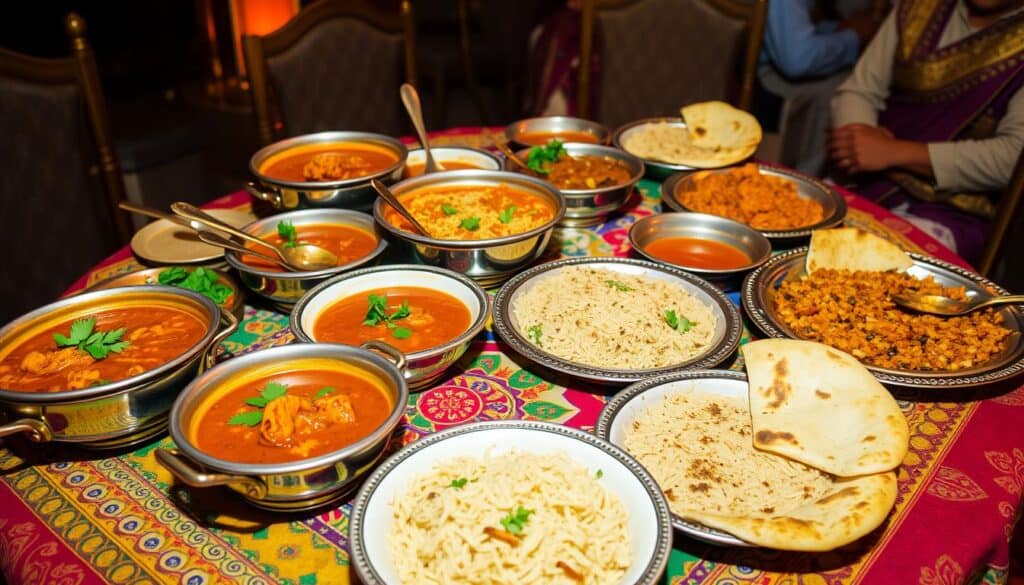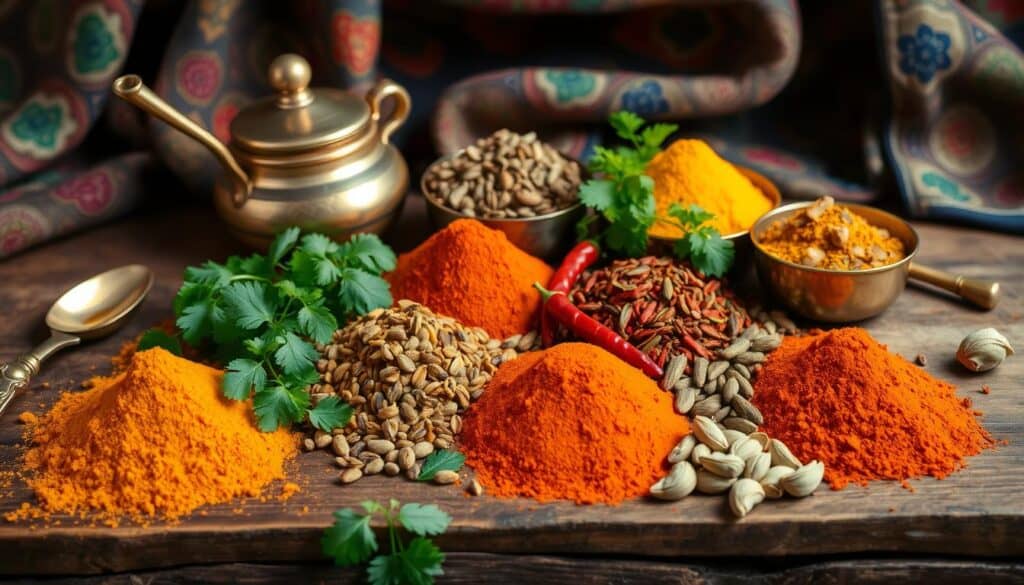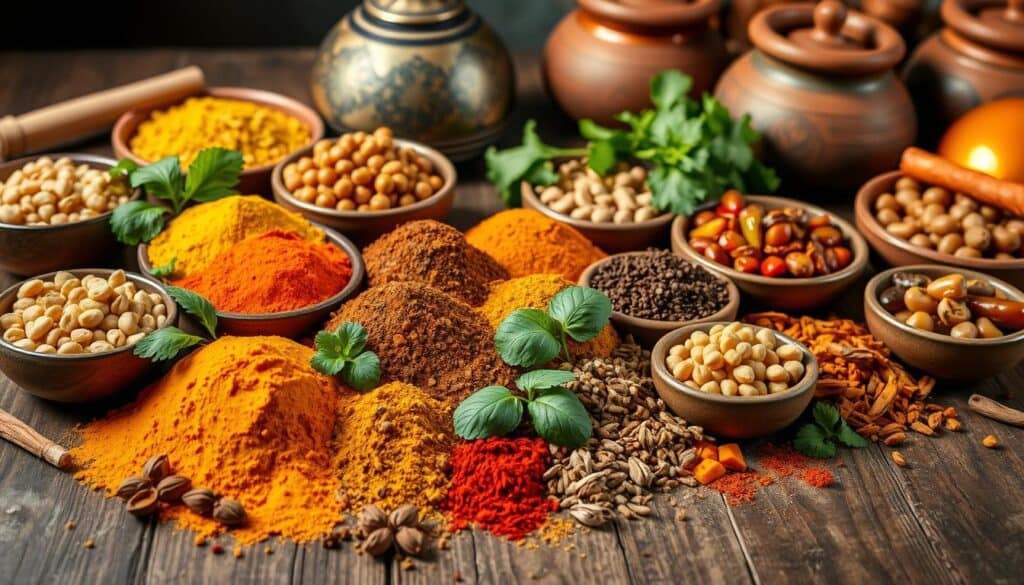Experience the rich flavors and aromas of Masala Indian Cuisine, a culinary tradition that showcases authentic Indian flavors and traditional Indian dishes. With its origins in India, Masala Indian Cuisine has become a staple in many parts of the world, offering a unique and flavorful experience for those who try it. From the warm spice mix of Garam Masala to the distinctive taste of Panch Phoron, every dish tells a story of centuries-old recipes and regional diversity.
Masala Indian Cuisine is a tapestry of flavors, textures, and aromas, celebrated worldwide for its diversity and richness. By incorporating Indian spices into everyday cooking, you can transform simple dishes like scrambled eggs and roasted vegetables, adding a pinch of turmeric and cumin for an authentic twist. Whether you’re exploring traditional Indian dishes or fusion blends, Masala Indian Cuisine has something to offer everyone.
Key Takeaways
- Masala Indian Cuisine offers a diverse array of dishes, with each dish representing a region, a culture, or a celebration.
- Garam Masala is a foundational spice blend in Indian cuisine, adding distinct and essential flavors to dishes across different regions.
- Indian spices like turmeric, cumin, and ginger play essential roles in Indian cooking, adding earthy, citrusy, and vibrant notes to dishes.
- Regional specialties in Indian cuisine feature unique spice blends, such as fennel, dry ginger, and asafoetida in Kashmiri cuisine.
- Cooking techniques like dry roasting spices and tempering with hot oil or ghee enhance flavors and aroma in Indian dishes.
- Masala Indian Cuisine has influenced global culinary traditions by introducing spices like turmeric, cumin, and ginger into various cuisines worldwide.
Introduction to Masala Indian Cuisine
Indian food restaurant enthusiasts often rave about the rich flavors and aromas of masala dishes. The best Indian restaurant experiences are often characterized by the bold use of Indian spices and flavors. At the heart of Indian cuisine lies the concept of masala, a blend of spices that adds depth and complexity to various dishes.
The use of masala in Indian cooking is an art form, with different regions and cultures developing their unique blends. From the warm, aromatic flavors of Garam Masala to the tangy, slightly sweet flavors of Chaat Masala, each blend is carefully crafted to enhance the taste of specific dishes. A visit to an Indian food restaurant is not complete without trying some of these iconic masala dishes.
What Is Masala?
Masala refers to a blend of spices, which can vary greatly depending on the region and type of cuisine. Common spices used in masala blends include turmeric, cumin, coriander, cinnamon, and black pepper. The proportion of each spice and the method of preparation can significantly impact the flavor profile of the final dish.
A Brief History of Indian Spices
Indian spices have been a cornerstone of the country’s cuisine for centuries. The use of spices like turmeric, cinnamon, and black pepper dates back to ancient civilizations. Over time, different regions developed their unique spice blends, often influenced by trade and cultural exchange. Today, Indian spices and flavors are enjoyed not only in Indian food restaurants but also in homes around the world.
- Garam Masala: a warm, aromatic blend commonly used in North Indian cuisine
- Chaat Masala: a tangy, slightly sweet blend often used in street food and snacks
- Biryani Masala: a complex blend of spices used to flavor biryani dishes
Whether you’re dining at the best Indian restaurant or experimenting with Indian spices and flavors at home, the world of masala has something to offer everyone.
| Masala Blend | Common Spices | Flavor Profile |
|---|---|---|
| Garam Masala | Cumin, coriander, cinnamon, cardamom | Warm, aromatic |
| Chaat Masala | Cumin, black salt, dried mango powder, asafoetida | Tangy, slightly sweet |
| Biryani Masala | Star anise, nutmeg, mace, saffron | Complex, slightly sweet |
Essential Spices Used in Masala Dishes
Indian cuisine is known for its diverse and complex use of spices, with over 40 different spices commonly used in traditional Indian dishes. However, some spices are more essential than others, and turmeric, cumin, and coriander are three of the most crucial spices used in masala dishes. These Indian spices and flavors are what give authentic Indian flavors their unique taste and aroma.
Turmeric: The Golden Spice
Turmeric is a crucial spice used in Indian cooking, and it is usually used in powdered form to add a golden color and earthy flavor to dishes. It is also known for its antibiotic and healing properties, making it a popular ingredient in traditional Indian dishes.
Cumin: Earthy and Aromatic
Cumin seeds are a staple in Indian cooking, and they are best used whole and fried in oil at the beginning of a dish. Cumin powder, also known as Jeera, is an essential spice in Indian cooking, used in almost all “regular” dishes such as dals, curries, pulaos, biryanis, and korma.
Coriander: Fresh and Citrus Notes
Coriander seeds are commonly used whole, roasted, and powdered in Indian dishes, providing a lemony and tangy flavor. Coriander powder, known as Dhania, is a crucial Indian spice used in major curry preparations, adding flavor to dishes and acting as a garnish for fresh chutneys and dips.
These essential spices are what give traditional Indian dishes their unique and authentic flavors. By combining these spices with other ingredients, Indian cuisine is able to create a wide range of delicious and complex dishes that showcase the diversity and richness of Indian spices and flavors.
| Spice | Usage | Flavor |
|---|---|---|
| Turmeric | Powdered form | Earthy and slightly bitter |
| Cumin | Whole and fried in oil | Earthy and aromatic |
| Coriander | Whole, roasted, and powdered | Lemony and tangy |
Types of Masala Blends
When it comes to Indian food, the best Indian restaurant often features a variety of masala blends that add depth and complexity to their dishes. Delicious Indian cuisine is all about the right combination of spices, and masala blends play a crucial role in achieving this. From the warm, comforting flavors of Garam Masala to the tangy, slightly spicy flavors of Chaat Masala, each blend has its unique characteristics and uses.
A visit to an Indian food restaurant would not be complete without trying some of the popular masala blends. Garam Masala, for instance, is a staple in many Indian dishes, including curries and stews. It is made with a combination of spices like cinnamon, cardamom, cloves, and black peppercorns, which gives it a distinct aroma and flavor. On the other hand, Chaat Masala is often used to add a tangy, slightly spicy flavor to snacks and street food.
Some other popular masala blends include Tikka Masala, which is known for its creamy, slightly spicy flavor, and Biryani Masala, which is used to make the popular Indian dish biryani. These blends are often used in combination with other spices and ingredients to create a unique flavor profile that is characteristic of Indian cuisine. Whether you are visiting the best Indian restaurant or trying to cook delicious Indian cuisine at home, understanding the different types of masala blends is essential to creating authentic and flavorful dishes.
| Masala Blend | Ingredients | Flavor Profile |
|---|---|---|
| Garam Masala | Cinnamon, cardamom, cloves, black peppercorns | Warm, comforting |
| Chaat Masala | Amchur, black salt, cumin, coriander, red chilli powder | Tangy, slightly spicy |
| Tikka Masala | Cilantro, cumin, coriander, cinnamon, cardamom | Creamy, slightly spicy |
Popular Masala Indian Dishes
When it comes to traditional Indian dishes, there’s a wide variety to explore, from the spicy flavors of Indian street food to the rich, creamy sauces found in the best Indian restaurant. Masala, a blend of spices, is a key component in many of these dishes, adding depth and warmth to each bite.
In the realm of traditional Indian dishes, some stand out for their popularity and flavor. Butter Chicken, for instance, is a creamy classic that has gained international recognition.  Masala Dosa, a crispy, fermented lentil and rice pancake from southern India, is a staple in many Indian households and restaurants, often served with a variety of chutneys and potato curry.
Masala Dosa, a crispy, fermented lentil and rice pancake from southern India, is a staple in many Indian households and restaurants, often served with a variety of chutneys and potato curry.
Butter Chicken: A Creamy Classic
This dish is known for its rich, buttery tomato sauce, flavored with a blend of masala spices, making it a favorite in many Indian restaurants.
Masala Dosa: South Indian Delight
Masala dosa is a popular Indian street food, offering a delicious combination of crispy exterior and soft interior, filled with spiced potatoes and onions.
Chana Masala: A Vegetarian Favorite
Chana masala, made with chickpeas in a flavorful tomato-based sauce, is a beloved dish in Indian cuisine, often served with basmati rice or naan bread, making it a staple in many best Indian restaurants.
Cooking Techniques in Masala Indian Cuisine
Cooking techniques play a vital role in bringing out the authentic Indian flavors in masala Indian cuisine. From the brief, intense heat of tadka to the long, slow process of slow cooking, each method is designed to develop the rich, complex flavors of Indian spices and flavors. The use of Indian spices and flavors is what sets delicious Indian cuisine apart, making it a favorite among many for its depth and variety.
Some key cooking techniques include:
- Tadka: Tempering spices in ghee or oil to release their flavors.
- Slow Cooking: Developing rich flavors over a long period.
- Marination: Infusing taste into ingredients before cooking.
These techniques, combined with the right blend of Indian spices and flavors, result in dishes that are truly representative of authentic Indian flavors. Whether it’s the creamy texture of a slow-cooked curry or the burst of flavors from a well-marinated dish, each bite is a testament to the power of traditional cooking techniques in delicious Indian cuisine.
By mastering these cooking techniques and understanding how to blend Indian spices and flavors, anyone can create delicious Indian cuisine that is both authentic and flavorful. The art of cooking with masalas is not just about following a recipe, but about understanding the nuances of each spice and how they interact with different cooking methods to produce authentic Indian flavors.
| Cooking Technique | Description |
|---|---|
| Tadka | Tempering spices in ghee or oil. |
| Slow Cooking | Developing rich flavors over a long period. |
| Marination | Infusing taste into ingredients before cooking. |
Vegetarian Options in Masala Indian Cuisine
Indian food restaurant menus often feature a variety of traditional Indian dishes that cater to vegetarian tastes. In fact, many Indian restaurants offer an array of options that are free from meat, making them ideal for vegetarians and non-vegetarians alike who prefer the flavors of Indian street food.
Some popular vegetarian dishes include palak paneer and saag paneer, which are made with spinach and paneer, a type of Indian cheese. These dishes are not only delicious but also packed with nutrients, making them a great option for those looking for healthy Indian food. Many Indian food restaurants also offer a range of vegetarian curries, such as chana masala and mixed vegetable curry, which are made with a variety of spices and herbs.
Paneer Tikka: A Vegetarian Favorite
Paneer tikka is a popular vegetarian dish that is made by marinating paneer in a mixture of spices and yogurt, then grilling it to perfection. This dish is often served with a side of naan or rice, and is a great option for those looking for a flavorful and satisfying vegetarian meal at an Indian food restaurant.
Mixed Vegetable Curry: A Seasonal Delight
Mixed vegetable curry is another popular vegetarian dish that is made with a variety of seasonal vegetables, such as bell peppers, carrots, and potatoes. This dish is often made with a mixture of spices, including cumin, coriander, and turmeric, which give it a unique and flavorful taste, reminiscent of traditional Indian street food.
Overall, Indian food restaurants offer a wide range of delicious and nutritious vegetarian options, making them a great choice for vegetarians and non-vegetarians alike who enjoy traditional Indian dishes and the flavors of Indian street food.
Non-Vegetarian Specialties in Masala Indian Cuisine
When it comes to non-vegetarian specialties in masala Indian cuisine, there are several dishes that stand out for their rich flavors and aromas. At a best Indian restaurant, you can expect to find a variety of options to suit every taste and preference. From the spicy kick of chicken curry to the smoky flavor of fish tikka, these dishes are sure to delight your senses.
A top rated Indian restaurant will typically offer a range of non-vegetarian specialties, each made with the finest ingredients and a blend of traditional spices. Whether you’re in the mood for something classic and comforting or adventurous and new, there’s a dish to suit your cravings. With its delicious Indian cuisine, you’ll want to come back for more.
Some popular non-vegetarian specialties in masala Indian cuisine include:
- Chicken curry: a staple dish made with marinated chicken cooked in a rich and creamy tomato-based sauce
- Fish tikka: a smoky and spicy dish made with marinated fish cooked in a tandoor oven
These dishes are not only flavorful but also made with the finest ingredients, ensuring a truly satisfying dining experience at abest Indian restaurant.
Pairing Masala Dishes with Sides
When it comes to enjoying authentic Indian flavors, pairing masala dishes with the right sides can elevate the overall dining experience. Traditional Indian dishes often feature a variety of sides that complement the bold flavors of masala. In Northern Indian cuisine, staple items like Naan, Rotis, and Parathas are commonly served with popular dishes like Chicken Tikka Masala.
Some popular side dishes that pair well with masala dishes include Raita, a spiced yogurt salad that helps balance the spiciness of Indian dishes. Other options like Papads, Vegetable Pakoras, and Potato Fry are also great accompaniments. Vegetables are an essential part of Indian menus, and it’s common to serve 2-3 vegetable dishes alongside the main course.
Here are some popular side dishes that complement masala dishes:
- Naan: a soft and delicious bread that pairs well with rich and creamy masala sauces
- Raita: a cooling yogurt salad that helps balance the spiciness of Indian dishes
- Papads: thin, crisp flatbreads that add a satisfying crunch to meals
- Vegetable Pakoras: crispy fried vegetables that make a great snack or side dish

Incorporating these sides into your meal can help create a well-rounded and satisfying experience, showcasing the rich and diverse world of authentic Indian flavors and traditional Indian dishes, all infused with the vibrant Indian spices and flavors.
| Side Dish | Popularity | Description |
|---|---|---|
| Naan | 55% | A soft and delicious bread that pairs well with rich and creamy masala sauces |
| Raita | 20% | A cooling yogurt salad that helps balance the spiciness of Indian dishes |
| Papads | 15% | Thin, crisp flatbreads that add a satisfying crunch to meals |
Cultural Significance of Masala Cuisine
Masala cuisine plays a vital role in Indian celebrations and family gatherings, bringing people together and creating lasting memories. The vibrant, colorful flavors of festival dishes and the warm, comforting flavors of family meals are all centered around masala. In fact, visiting an Indian food restaurant or the best Indian restaurant during festivals is a common practice, where people enjoy a variety of Indian street food.
The cultural significance of masala cuisine is evident in its ability to evoke emotions and create a sense of community. Whether it’s a wedding, a festival, or a simple family dinner, masala dishes are always at the center, bringing people together and creating memories that last a lifetime. For instance, the smell of certain masala spices can transport people back to their childhood, reminding them of family gatherings and special occasions.
In India, masala cuisine is not just about the food; it’s about the experience. It’s about the people, the culture, and the traditions that come together to create a unique and unforgettable experience. Whether you’re visiting an Indian food restaurant or enjoying a homemade meal, the cultural significance of masala cuisine is undeniable. So, the next time you visit the best Indian restaurant, remember the cultural significance of masala cuisine and the role it plays in bringing people together.
Health Benefits of Spices in Masala Cooking
Masala cooking, known for its authentic Indian flavors, offers a wide range of health benefits due to the Indian spices and flavors used. The delicious Indian cuisine is not only a treat for the taste buds but also provides numerous advantages for overall well-being. From reducing inflammation to boosting digestion and immunity, the spices used in masala cooking have been found to have a significant impact on health.
Some of the key health benefits of spices used in masala cooking include:
- Anti-inflammatory properties: Turmeric, a common spice used in masala cooking, contains curcumin, which has strong anti-inflammatory properties.
- Boosting digestion: Cumin, coriander, and other spices used in masala cooking have been found to aid in digestion and relieve symptoms of irritable bowel syndrome.
- Immunity boost: The antioxidants present in spices like cinnamon, cardamom, and cloves help protect the body against damage caused by free radicals and support immune function.
Incorporating these spices into your diet can have a significant impact on overall health. With their numerous health benefits and delicious flavor, it’s no wonder that authentic Indian flavors and Indian spices and flavors are becoming increasingly popular in delicious Indian cuisine.

By understanding the health benefits of spices used in masala cooking, individuals can make informed decisions about their diet and lifestyle, ultimately leading to a healthier and more balanced life.
| Spice | Health Benefit |
|---|---|
| Turmeric | Anti-inflammatory properties |
| Cumin | Boosting digestion |
| Coriander | Aiding in digestion and relieving symptoms of irritable bowel syndrome |
| Cinnamon | Antioxidant properties and supporting immune function |
Tips for Cooking Authentic Masala Indian Cuisine
Cooking authentic masala Indian cuisine requires attention to detail and a focus on quality ingredients. A top rated Indian restaurant would always source the freshest spices, meats, and vegetables to create traditional Indian dishes. To achieve this at home, it’s essential to understand the importance of sourcing quality ingredients and balancing flavors.
When visiting an Indian food restaurant, you may notice the distinct flavors and aromas of various spices. To replicate this at home, try using fresh ginger and garlic as building blocks of Indian cuisine. You can also experiment with different spice blends, such as garam masala, to add depth and warmth to your dishes.
Sourcing Quality Ingredients
Sourcing quality ingredients is crucial for creating authentic masala Indian cuisine. Look for fresh and high-quality spices, such as cumin, coriander, and turmeric, to add flavor and color to your dishes. You can also try visiting a local Indian market or store to find specialty ingredients, such as curry leaves and mustard seeds.
Balancing Flavors
Balancing flavors is an art in Indian cooking, and it requires a delicate balance of sweetness, sourness, and spiciness. To achieve this, try using a combination of spices, such as cumin, coriander, and garam masala, and adjust the amount of chili peppers or cayenne pepper to suit your taste. You can also add a splash of lemon juice or vinegar to balance the flavors.
By following these tips and experimenting with different ingredients and spice blends, you can create delicious and authentic masala Indian cuisine at home, just like a top rated Indian restaurant. So, go ahead and explore the world of Indian cooking, and don’t be afraid to try new recipes and ingredients to create your own unique dishes.
Conclusion: Embarking on a Masala Journey
As you’ve discovered, the world of authentic Indian flavors and Indian spices and flavors is a culinary adventure waiting to be explored. Whether you’re dining at a local delicious Indian cuisine restaurant or trying your hand at masala recipes at home, the possibilities for experiencing the vibrant tastes of India are endless.
Start your masala journey by seeking out reputable Indian eateries in your area. Explore the diverse menu offerings, from classic authentic Indian flavors like butter chicken and chana masala to regional specialties that showcase the depth of Indian spices and flavors. Engage with the staff, ask for recommendations, and don’t be afraid to venture beyond your comfort zone.
For the homecooks among you, embrace the challenge of recreating delicious Indian cuisine in your own kitchen. Invest in high-quality spices, learn the art of balancing flavors, and experiment with traditional cooking techniques. The satisfaction of crafting a flavorful masala dish from scratch is truly unparalleled.
